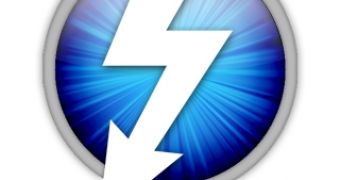Apple is not the owner of the Thunderbolt trademark, Intel is, according to the latter’s communications manager, Dave Salvator, who provided an official statement on the matter.
Although Patently Apple did discover that Apple had filed for the Thunderbolt brand name trademark, it’s still Intel’s to own, says the chip maker.
Apple simply helped with the filing, according to the company’s communications manager. They filed for the original trademark and they’re now transferring it back to Intel. That’s all there is to it, says Salvator:
“As part of our collaboration with Apple, they did some of the initial trademark filings. Intel has full rights to the Thunderbolt trademark now and into the future. The Thunderbolt name will be used going forward on all platforms, irrespective of operating system.”
But others claim there are two sides to this story.
Apple reportedly also filed a Thunderbolt trademark in November 2010, as well as one that surfaced in the United States Patent & Trademark Office’s database on May 11, 2011.
Salvator also indicated that Intel is working to design the optical version of the technology, saying "The (Thunderbolt optical) cable could carry power in the same cable (running next to optical part of cable), but exact product plans are still to be announced."
Originally named Light Peak, Thunderbolt is an interface for connecting peripheral devices to a computer via an expansion bus.
Although developed by Intel, it was Apple who originally unveiled it in a commercial product - the most recent line of MacBook Pro computers.
Since then, the company’s iMacs also added Thunderbolt support, leaving the MacBook Air and Mac minis next in line to feature the I/O tech.
Intel’s Thunderbolt technology permits data transfer speeds of up to 10 Gbps. For example, using it you can transfer a full-length HD movie in roughly less than 30 seconds, or back up a whole year of continuous MP3 playback in just over 10 minutes.
This high-speed data transfer technology features dual-channel 10 Gbps per port; is bi-directional; dual-protocol (PCI Express* and DisplayPort*); it’s compatible with existing DisplayPort devices and daisy-chained devices; it uses electrical or optical cables; and features low latency with highly accurate time synchronization.

 14 DAY TRIAL //
14 DAY TRIAL //